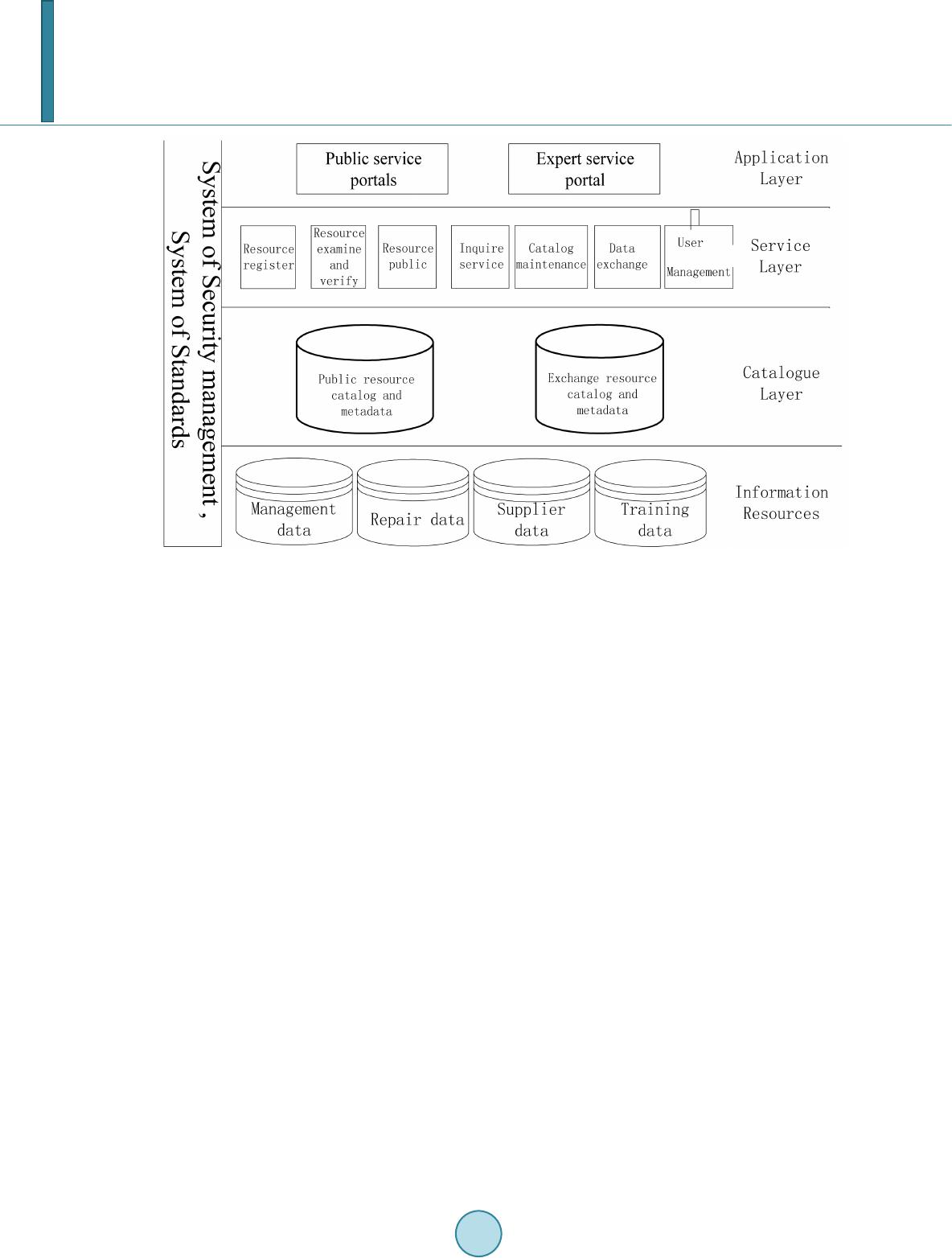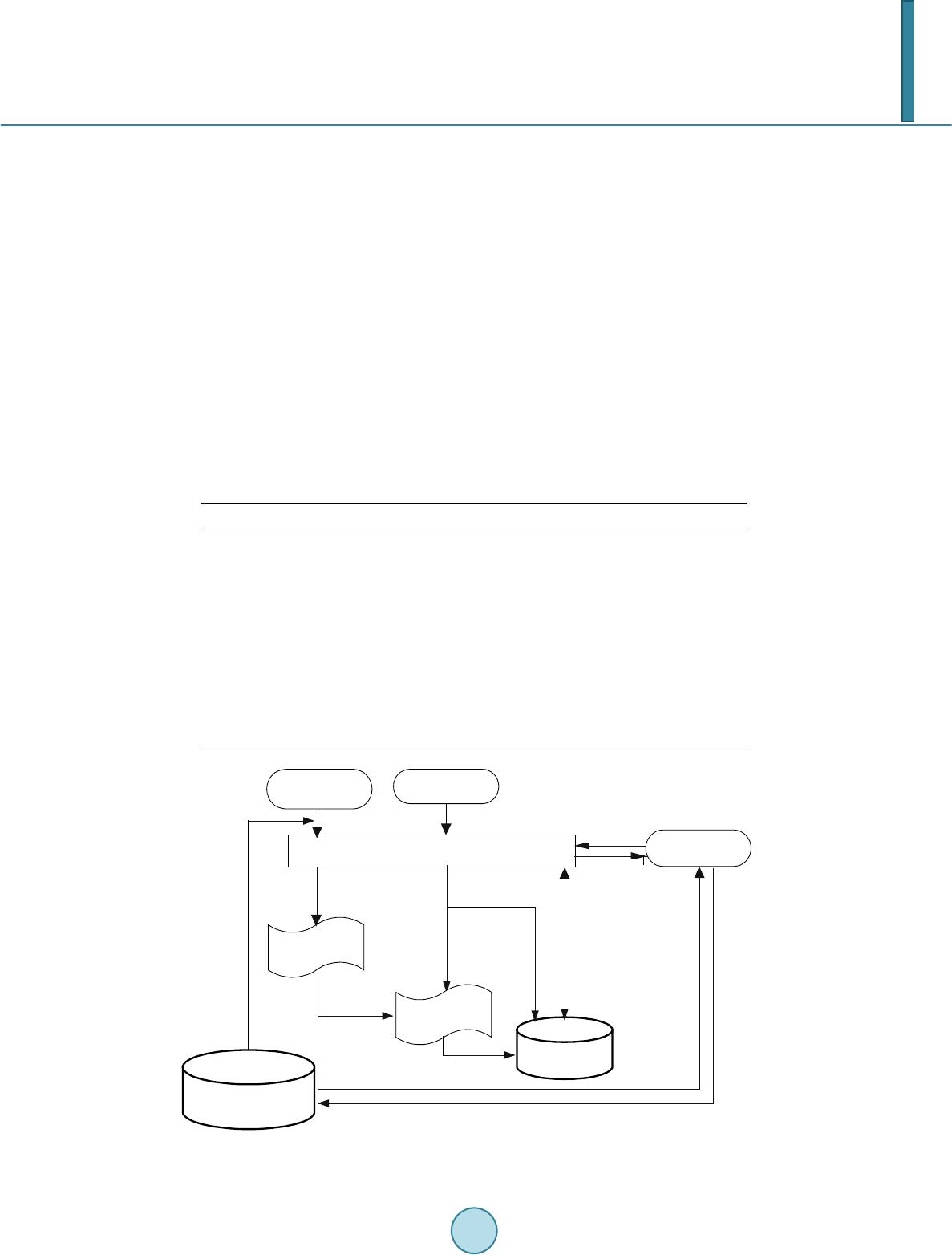 Open Journal of Social Sciences, 2014, 2, 19-24 Published Online March 2014 in SciRes. http://www.scirp.org/journal/jss http://dx.doi.org/10.4236/jss.2014.23004 How to cite this paper: Dai, D.S., et al. (2014) Research on the Design of Machine Support Information Resource Catalog Service System. Open Journal of Social Sciences, 2, 19-24. http://dx.doi.org/10.4236/jss.2014.23004 Research on the Design of Machine Support Information Resource Catalog Service System Dongsheng Dai1, Zhengzheng Li2, Weining Ma2, Diyang Jia1 1Machine Technology Institute, Shijiazhuang, China 2Machine Engineering College, Shijiazhuang, China Email: jiadi yang@sina. com Received Oct ober 2013 Abstract The machine support information resource has many characters, such as large quantity, disper- sive storage and low usage level etc. It resea rch es the machine support information resource cat- alog service system. It analyzes the machine support information resource and the functions of the information resource catalog service. Based on this, it establishes the architecture of the informa- tion resource catalog server system. Then, it designs the information resource metadata and ex- plains the building process and work process of the information resource catalog. Keywords Information Resource Catalog; Metadata; Machine Support 1. Introduction As the demand for machine management being more and more elaborate and machine support being more and more accurate, the data volume related to the machine support grows with each passing day, and the usage re- quirements of the service information are rising accordingly. At present, the business information that is sepa- rated according to the division of functions is managed by different business personnel. The overall lack of sys- tematic, relevance and consistency and its utilization level and using efficiency are also relatively low. It is dif- ficult to provide effective information services for integrated business operation. Machine support information resource catalog service system can make the dispersed information resources under the network environment organized, managed and recorded comprehensively. It can greatly facilitate the business staff to gain access to the resources that are needed. Thus, it can improve the efficiency in the use of information resources and opera- tion services. 2. Machine Support Information Resource [1] 2.1. The Concept of Machine Support Information Resource Special information resource refers to the information content, information itself or a collection of information.  D. S. Dai Generalized information resource is a multi collection of elements throughout the information activities of the human society in which that is engaged in the production, distribution, exchange, circulation and consumption of the whole process, including the object, technology and laborers of information on labor. In comparison, the special information resources highlight the core and essence of information resources, also easy to understand. Machine support work used and produced a large amount of information resources in the process of business operation such as use, management, repair, keeping fit, components supply and the command which ensure the machine support management department effectively control daily management, the quality and quantity moni- toring, statistical analysis, decision support, etc. These information resources various in manifestation modes and storage formats. According to the functional features, these information resources can be divided into dy- namic information, statistical information, auxiliary decision information, and other information. According to system processing methods and storage format, these information resources can be divided into numeric type, text, multimedia business information in which being performed as independent data files, application system data, business documents, etc. 2.2. The Present Situation of Machine Support Information Resource [2] With the long-term accumulation of business and the construction of business application system, machine sup- port information resources exhibit the following characteristics: 1) There is a wide range of information resources with huge numbers. Advance in information technology, the development and construction of the machine system, and the increasing management requirements making the machine support information resources exploding. Business people from different applications and different division are saved with a large number of system data, business information, standards and other information resources which are produced by machine support work. These information resources accumulated year after year, some are increase of amount, while others are of kinds. 2) Lacking of a unified organization and management. During the machine support entire life cycle, a large number of information resources classified by business or the division of labor are decentralized management, information resources which grasped by different business personnel are often limited in their business scope. Overall, these information resources, fragmented, lack of systematic, normative and relevance, cannot be effec- tively organized and managed. 3) Low level of sharing, difficult to use. Decentralized management makes it hard for business people to know the types of information resources, storage location and access of information resources, etc. Subject to individual capabilities, cross-business, cross-stage information resources are even more difficult to find, the pre- cision of information, recall, and availability are unable to meet. In the view of the situation of machine support of information resource management, must be systematically analyzed, to establish a scientific and standardized management system, in order to effectively massive informa- tion resources, providing better protection for the entire life of the device information resources to support the busine ss. 3. Machine Support Information Resource Catalog Machine support information resource catalog is a layering data structure of the machine support information resource under the network environment, which used to organize and manage information resources, also an important basic work for information resource construction. 3.1. Functions of the Information Resource Catalog [3] The major function of the machine support information resource catalog includes: 1) Resource information organization. Information resources catalog record information resources in a net- work details, and the complex relationship between these resources. Catalog service is able to fully consider the distribution network with the characteristics of unity, the actual situation of the information resources and cata- log one-to-one correspondence, in the form of network resources view resources, so the direct management of information resources via catalog services can be carried out. 2) Resource information management. Directory information resources in a uniform manner of specification  D. S. Dai and classifying information resource description, in the hierarchy to storage of information resources, so as to promote the sharing of dispersed information, integration, integration and interoperability. At the same time, it can establish the relationship between information resources and users, with the flexibility to control user access to information resources, ensure the safety of catalog information resources. 3) Information resource usage. Through information resources catalog, the ability to make a horizontal inte- gration, the information resource for the users to know clearly what the network resources they need resources are located, and how to obtain these resources. 3.2. Principles of the Establishing Information Resources Catalog [4] Through the construction of information resource catalog system, First, clear departmental status and characte- ristics of information resources; Second, a clear information resource collection, maintenance, updating the management responsibility for the unit; Third, lay the foundation for the unified management of information re- sources, publishing, query and location-based services; Fourth, by clarifying the information sharing needs in every business areas, grasp the overall situation of application system and database construction. The establishment of information resources catalog should adhere to the following principles: 1) Systemic. It should be based on the protection business, system, comprehensive, accurate description and display machine safeguard relevant to the information resources. 2) Normalization. The establishment of the catalog should conform to the requirements of relevant national standard, targets, standards and specifications. 3) Practicality. Catalog after the establishment should ensure that it is available, convenient, and easy to use to quickly and accurately find simple resource information and resource access. 4) Extensibility. Catalog should be flexible according to the need for flexible modification and expansion, so that the information may appear in the future resources can be included in the catalog system. 4. Design of the Machine Support Information Resource Catalog Service System [5] 4.1. Architecture Machine support information resources catalog service system is based on metadata unfolds, physically dis- persed information resources logically centralized management. Users can within the scope of permission query and access to information resources. Machine support information resource catalog service system architecture is shown in Figure 1. Machine protection of information resources catalog service system mainly includes information resource, catalog layer, service layer and application layer four levels. Functional description of each layer is as follows: 1) The information resource layer. Refers to the machine protection levels and departments at all levels can available or can be exchanged between the individual department and machine used in safeguarding information resources, mostly in the form of a database. 2) The catalog layer. According to the nature of the use of information resources, the machine support infor- mation resources catalog is divided into public resources and the exchange of resources catalog, respectively corresponding to the public resource metadata database and exchanging resource metadata database, satisfy the public information service and two types of specialized information service needs. 3) The service layer. Resource Catalog provides device support information service platform’s core services in response to the needs of the application layer for various services, including registration, examination, ap- proval and release information resources catalog, query and maintenance, data exchange and user management, etc. 4) The application layer. Is a display layer for users of the catalog service, provides various user interfaces for users to visit information resources. Different users can query and gain the results that according to the authority and demand for catalog content. 4.2. Design of the Information Resource Metadata In the information resources catalog service system, the metadata is the core media of the information resource description, management and query, is also an important part of information resources catalog. Based on the Dublin core metadata, the system combined with the actual machine support demand is appropriately altered and  D. S. Dai Figure 1. The architecture of catalog service system. extended, the metadata of management objects are designed as shown in Table 1. Among them, the type said the metadata storage type, “S” as a string type, “D” for the date. Among them, the resource name, identifier, resource category, source file format, permissions, resource loca- tion submit person, and submit time are metadata that required, other metadata can be chose according to users’ needs. 4.3. The Establishment of Information Resources Catalog [6] The establishment of the machine support information resources catalog needs to go through many processes, such as catalog content registration, examination and approval, release and maintenance, and then, it formed a complete and accurate describe about information resources, only by doing this can it provide services for users. Among them, resource provider is responsible for the registration and maintenance of the resource information, system administrator is responsible for review and release resource information. 1). Catalog registration: Authorized user should file an application for resource registration, and fill or submit the resource description information according to the requirements of metadata. To fill the resource information we should ensure that the availability, accuracy, and comprehensiveness of the information. The resource infor- mation can be edited or deleted before it was examined and verified. 2) Review of catalog: system administrators review the registration information, to ensure that users register full effective resource information and resource content comply with security requirements. Approval of re- source information can enter the metadata database, and increase the resources in the catalog. The resource in- formation which is not through should feedback error message to the resource provider timely. 3) Catalog publishing: managers can publish content after the audit, including public resources core metadata catalog and exchange service core metadata catalog. Information resource metadata use the principle of “who provide maintenance”, the catalog content providers can ask managers requests, release or delete their resources accordingly modify. 4) Maintenance and management: the user can find the information quickly according to the attributes of the object in the catalog system and service resources. Maintenance refers to the catalog content managers to super- vise and control the corresponding metadata information resources. Because the metadata maintenance is to maintain the published information resource metadata, it refers to delete the information metadata resource mainly.  D. S. Dai 4.4. The Workflow of the Information Resource Catalog System [6] Machine support information resource catalog process is shown in Figure 2. The catalog workflow includes three roles which are catalog provider, managers and catalog users. Including: 1) The catalog provider is the operating department or the management department of the machine support information resource. It is responsible for making a catalog according to this department’s machine support in- formation resource follow the metadata standard, and then submit the cataloged information resource metadata to the manager for review. 2) Catalog manager is responsible for checking the information resource metadata that exhibitors provided. Catalog manager is responsible for checking the information resource metadata that exhibitors provided, and then publish the information resource metadata audited through; at the same time, it may be in charge of main- tenance and management of the entire catalog system. 3) Users of the catalog query through the catalog service system and locate information resources they re- quired, they also visited the required information resources within the scope of the appropriate permission ac- cording to the result that system feedback. Catalog service needs to be combined with security service to realize the resource access control functions, users who possessed access authentication can inquire the appropriate catalog information, and obtain the Table 1. Data resource metadata. order number definition type order number definition type 1 Resource Name S 9 Relevance S 2 Identifier S 10 Permissions S 3 Resource Illustration S 11 Resource Location S 4 Keyword S 12 Submit Person S 5 Resource Genre S 13 Submit Time D 6 Resource Category S 14 Submit Place S 7 Source File Format S 15 Submit Unit S 8 Resource Update Cycle S 16 Edition S Figure 2. The workflow of the information resources catalog. Catalog Service System show record registe r retrieval inquiry result publish metadata Information resources Database exhibitor manager User locatio n Metadata Database examine and verify metadata be laid up mainten ance  D. S. Dai needed resource. In the cases that information resource and catalog structure are more complex, we need to pro- vide a variety of retrieval ways, such as provide standard call interfaces for application system to support the query for core metadata of the emergency information resources; Provide the human-computer interaction way of catalog content query function; Provide the human-computer interaction way catalogue center address infor- mation query function. 5. Conclusion Machine support information resource catalog service system provides a great convenience for the query and access of information resources. Being related to the comprehensive database that is established by the machine security’s departments at all levels is very good for improving the availability and the standard of information resources. It can also provide effective and efficient ways or means for the decentralized management, unified organization and efficient sharing of information resources. At the same time, the establishment of the informa- tion resource catalog is a long-term, fundamental work, which needs a lot of manpower and material resources to maintain and update continuously. Only by doing this, can we reach the expected result. References [1] Qin , T.H. (2006) Enterprise Information Resource Management. Peking University Press, Beijing. [2] Ma, F.C., Li, G. and Zha, X.J. (2001) Information Resources Management. Wuhan University Press, Wuhan. [3] Huang, M.F. (2010) Urban E-Government Spatial Information Resources Catalog Service System Study. T ranspo rta- tion Standardization, 16, 153-156. [4] Zhang, F., Li, S.H. and Wei , H.Y. (2008) A Preliminary Study on the Marine Information Resources Catalog Service System Design. Journal of Geographic Space Information, 4, 81-83. [5] Fen g, J., Tang, Z.X., Huang, R.C., et al. (20 11) The Water Conservancy Information Resources Metadata Management Method Research. Journal of Water Conservancy Informationization, 5, 1-4. [6] Sudharshan, V., Steven, T. and I an, F. (2001) Replica Selection in the Globus Data Grid. 4, 2-6.
|